Sevilla - Spain
Overview: Highlights of Sevilla with stops at the major attractions
Duration: 3 days
Locations visited: Catedral de Sevilla, Royal Alcázar of Sevilla, Plaza de España, Parque de María Luisa, Guadalquivir River, Triana, & Macarena
How to get there: Fly into Sevilla Airport (SVQ)
How to get around: Taxi, Walking
When to go: Fall, Winter, or Spring - we went around New Year’s
Pace: Moderate
Future trips: Madrid, Granada, Valencia, Balearic Islands
Plaza de España
Day 1: Plaza de España, Parque de María Luisa, Guadalquivir River, & Triana
We spent our first day in Sevilla walking around many of the popular locations. Most of the focus was on outdoor activities, with tours scheduled for the second day. We walked from our hotel to the Murillo Gardens, passing by the Catedral de Sevilla on the way (which we toured the following day). The most famous attraction in the gardens is the Medallón de Cristóbal Colón, or Monument to Christopher Columbus.
Crossing through Plaza Don Juan de Austria, we continued towards Parque de María Luisa, home to the Plaza de España. This is one of the most iconic and most photographed locations in Sevilla, if not all of Spain. Visitors can walk around the plaza and the surrounding government buildings or rent a small boat to row in the canal. The plaza and park were built in 1928 for the Ibero-American Exposition World's Fair. Around the plaza are tiled alcoves, each representing a different province of Spain.
After exploring Plaza de España, there was plenty to see in Parque de María Luisa. The park, originally the gardens of the Palace of San Telmo, serves as a botanical garden with a distinct Moorish style. Inside, there are multiple statues and sculptures, including the Monument to Gustavo Adolfo Bécquer, Monument to la Raza, The Fountain of the Lions, and Monument to Miguel de Cervantes. Also located here is the Museum of Popular Arts and Traditions.
West of the park, before reaching the Guadalquivir River, we passed the Pabellón de Argentina, a striking gold and white building constructed for the Ibero-American Exposition. Today, it houses a dance school.
Continuing west, we reached the Guadalquivir River and its many sights and bridges. One of the highlights is the Torre del Oro, a defensive tower built in 1220, which now houses a naval museum.
From here, we crossed the Puente de Triana into the Triana neighborhood. Directly across the river is the Capilla Virgen del Carmen, a small chapel. Triana is well known for its ceramics, making it a great spot to browse local shops.
This wrapped up our first day in Sevilla. We returned to our hotel and watched a Flamenco performance in the lobby.
Day 2: Catedral de Sevilla & Royal Alcázar of Sevilla
Our second day in Sevilla was dedicated to two of the most popular attractions: The Royal Alcázar of Sevilla and Catedral de Sevilla, including its clock tower, the Torre Giralda. Both are UNESCO World Heritage Sites. We booked a group tour that covered both sites and included entry tickets.
On the way to meet our tour group, we walked past the Palacio Arzobispal. If missed earlier, it can also be seen when visiting the Cathedral.
The Royal Alcázar of Sevilla dates back to the 10th century as a Moorish-style citadel. Around 1250, the Castilian rulers added a Gothic-style palace, and in the 14th century, further modifications were made in Mudéjar style. This blend of architectural styles gives the palace a unique charm. Highlights include Puerta del León, Sala de Justicia, Patio del Yeso, Patio de la Montería, Patio de las Doncellas, Los Baños de Doña María de Padilla, and the Salón de los Embajadores, as well as the gardens. The palace is stunning, but the tour felt rushed, and I wished we had more time for photos, especially in the gardens. I'd be curious to know if visiting without a guide is possible.
Next, we walked with the tour group to Catedral de Sevilla (Catedral de Santa María de la Sede), stopping briefly at various landmarks. When completed in the 16th century, this became the largest cathedral in the world, surpassing Hagia Sophia. Built over a 12th-century mosque, elements of the original structure were incorporated into the cathedral, which contains 80 chapels. After the tour, those interested could climb to the top of the Torre Giralda for panoramic city views.
These visits did not take the entire day, leaving time to explore other spots, grab food or drinks, or relax.
Day 3: Macarena
On our final half-day in Sevilla, before heading to the airport, we explored the Macarena area. We started at the Alameda de Hércules, a plaza featuring Roman columns, including those dedicated to Hercules.
Next, we visited the Basílica de la Macarena and nearby Arco de la Macarena before checking out the historical Macarena Walls, which date back to Moorish rule. Across the street are the Andalusian Parliament buildings, worth a visit if time allows. Although Parque de los Perdigones is nearby, we didn’t have enough time to visit.
To wrap up the trip, we briefly visited Parroquia de San Pedro Apóstol and the Setas de Sevilla, a modern architectural structure that houses an archaeological museum.
Sevilla is an incredible city full of history, stunning architecture, and lively culture. Three days felt like a good amount of time to see the major highlights. If you're planning a trip, make sure to book tickets for major attractions in advance and leave time to simply wander and enjoy the city's charm.
































